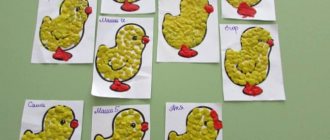Middle group. Junior preschool age. Children 4 - 5 years old
Summary of the conversation in the middle group “The Nativity of Christ” Summary of the conversation in the middle group “The Nativity of Christ”
Goal: to introduce children to the history of the Orthodox holiday of the Nativity of Christ; give an idea of its meaning. Objectives: - to instill respect and love for the Orthodox traditions of your people; - educate emotional...
Summary of an educational conversation in the middle group “Siege Bread” Educational conversation “Siege Bread”
middle group Purpose: to study the history of the country and the city, to give children an idea of the heroic feat of the inhabitants of besieged Leningrad.
To foster patriotism, a sense of pride in their courage and perseverance. Reinforce the concept of “siege bread”
….
Methodological techniques for organizing a conversation
The main technique in working with younger preschoolers is play. In addition, when conducting a conversation, the teacher uses:
- explanations, riddles, poems, fairy tales to introduce the topic of conversation, as well as consolidate the material,
- pictures to accompany conversations on any topic (conversations on the topic of CGN are illustrated with drawings with diagrams of performing certain actions, for example, the procedure for washing, dressing),
- games (usually in this way the teacher combines a conversation - a verbal technique - with physical education, a game element of the lesson, or with a walk - part of the regime),
- drawings, applications to consolidate acquired knowledge on the topic (for example, after the final conversation on the topic “Winter”, children make an application of the winter symbol - a snowman, using cotton pads and felt-tip pens to indicate the eyes, mouth and nose).
Practical ways of interacting with children help kids better grasp the material of the conversation
Recommendations for conducting a conversation in the first junior group
- Sufficient provision of visibility . A conversation without illustrative material turns into a verbal technique in its pure form, which for children 1.5–3 years old does not give clear ideas. Moreover, over time, this practice will teach the children to talk about things about which they have no figurative idea.
- Patience. If the teacher knows for sure that the children’s experience allows them to answer the question posed, it is not worth giving the answer for the kids in the name of maintaining timekeeping. It is better to ask leading questions so that the children have the opportunity to experience a situation of success by answering correctly.
- Less is more. Do not overload the conversation with long monologues and a large amount of information. This will cause nothing but fatigue in children. Do not forget that children aged 1.5–3 years cannot live without games.
- Inclusion of everyone, not just active ones. Often the teacher involves only initiative children in the work. Meanwhile, a shy child can be drawn into a conversation with encouragement, even if he repeated the answer given by another child: “Well done! You noticed it too!” It is important not to be distracted in conversation by naughty children. They need to be placed closer to you and ask questions more often, making sure to note the key points in their statements.
Shy children should also be included in the conversation along with active ones.
- Conversations (especially situational ones) on the topic of KGN should not be started with reproaches, like: “Just look at your noses!” - and long maxims about how no one has headscarves, the pupils do not know how to blow their noses, use a washbasin, etc. The first reaction of the kids will be to squint their eyes towards their noses in order to see the object of the adult’s dissatisfaction, but the teacher’s only goal was to lead the children to that you need to wear handkerchiefs. When asked the final question: “So what should you bring tomorrow?” the guys will list everything they want, but they may never get to the scarves. Therefore, it is more appropriate to start with the introduction of the guest - Petrushka, with whom the toys do not want to be friends, because he does not know how to use a handkerchief. And then tell you step by step how to avoid ending up in a similar situation for the kids themselves.
Development of material on the topic of individual conversation
Summary of an individual conversation with parents.
1. Object of conversation:
student's parents.
2. Topic of conversation:
“How to overcome a child’s shyness and insecurity”
3. Purpose of the conversation
: to form parents’ ideas about the impact of a child’s shyness and uncertainty on educational success.
4. Objectives of the conversation:
a) establish psychological contact with parents;
b) discuss with parents the problem of the influence of shyness and uncertainty on the student’s educational success;
c) contribute to the formation in parents of a desire to help their own child overcome shyness and uncertainty;
d) discuss with parents ways to overcome the child’s shyness and uncertainty at home and at school.
5. Conversation plan:
1) Greeting;
2) Main part;
a) The theoretical aspect of the emergence of shyness and uncertainty;
b) Questions asked to parents;
c) Questions that parents have;
d) Memo for parents on overcoming shyness and self-doubt in their children.
3) Conclusion.
Contents of the conversation
(supporting concepts, questions, conversation structure).
Greetings:
Hello! I would like to have a consultative conversation with you on the topic “How to overcome a child’s shyness and insecurity.”
Main part:
Even in the most extreme and neglected
forms of shyness and uncertainty will pass,
if you put in the work of your soul to overcome them.
V. Levi
Almost every person experiences a feeling of fear in their life. Some people are afraid of heights, others are afraid of snakes. But this can be avoided in life. What about those who are afraid of people? First of all, this applies to shy people and insecure children. They feel insecure with their peers during recess and even more so in class. Such children may know all the educational material of the lesson, but are afraid to raise their hand, answer in front of the class, afraid to make a mistake.
Often teachers who work with such students get the impression that they have low intellectual potential, a narrow outlook, and undeveloped learning skills. A child who subtly senses the teacher’s attitude toward himself becomes withdrawn, closed, stops communicating with peers, and tries to run home from school as quickly as possible. Gradually, this state of affairs forms his low status in the team.
A bleak picture, isn't it?
(Parents' answers)
And if he does not receive support and attention at home, the situation can turn into a tragedy.
(Parents' questions)
Shyness is a flexible concept; The more closely we look, the more varieties we see. Therefore, even before we begin to figure out what to do with it, it doesn’t hurt to learn more about it.
The Oxford English Dictionary reports that the first written use of the word "shy" was after the birth of Christ and meant "easily frightened." “To be shy” means to be “difficult to approach because of timidity, caution, or mistrust.” A shy person is “apprehensive and disinclined to meet or have contact with any particular person or thing.” “Impressive, timid, reluctant to assert his rights,” a shy person may be “prone to solitude or secretive due to lack of self-confidence” or due to fear of harassment, his antipode, “doubtful, suspicious, “dark” personality.”
Webster's Dictionary defines shyness as “awkwardness in the presence of other people.”
(Parents' questions)
Shyness occurs when a child concentrates on what others, especially strangers, think about him. He is afraid that he will not meet other people's expectations and will be rejected. Tension affects his physiological state. He blushes, speaks haltingly and quickly, and becomes clumsy.
4 reasons for shyness:
1. Children are more sensitive and impressionable to this behavior and react sharply to any changes and conflicts. Therefore, any careless word or unpleasant situation can make them withdraw into themselves. Often such children grow up in families where parents try to constantly control their behavior.
2. Deprived of freedom, the child loses self-confidence and independence.
3. Endless criticism is also the reason for the formation of shyness. When children are criticized too often, they stop doing anything to avoid making mistakes and being pressured. It is more difficult if critical parents also compare the child with a more successful brother or friend.
4. And finally, children can simply copy the behavior of their parents. If there is a shy father or mother in the family, then the child simply will not have an exemplary example symbolizing self-confidence.
Memo for parents.
Here are some rules to follow when interacting with your shy child.
1. Praise your child for achievements that were achieved through hard work and perseverance.
2. Condemn not the child, but his unworthy actions.
3. Set feasible goals for your child and evaluate their achievement.
4. Do not ignore any child’s efforts to overcome self-doubt.
5. Have a heart-to-heart talk with your child, give them the opportunity to speak out and share their painful issues.
6. Do not prevent your child from making mistakes, do not replace his life experience with yours.
7. Do not instill in your child fear and apprehension towards yourself.
8. Ask your child if he doesn’t tell you anything, do it tactfully and warmly.
9. Rejoice in his victories over himself.
10. Be there for him if he needs it!
6. Literature used when preparing the conversation:
1. Zimbardo, F. Shyness / F. Zimbardo. – M.: Pedagogy, 2005. – 284 p.
2. Vachkov, I.V. Group methods in the work of a school psychologist / I.V. Vachkov. – M.: Os, 2009. – 179 p.






